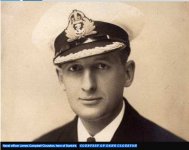http://montrealgazette.com/news/local-news/inspiration-for-summer-blockbuster-dunkirk-an-unsung-montreal-hero
Inspiration for summer blockbuster Dunkirk an unsung Montreal hero - René Bruemmer, Montreal Gazette - Aug 2, 2017
The real-life hero of this summer’s blockbuster movie Dunkirk, which portrays the valiant effort of naval officers and civilians to evacuate more than 300,000 Allied soldiers trapped by the Germans during the Second World War, was a Canadian who grew up in Montreal and attended McGill University.
Yet the name of James Campbell Clouston, who is credited with saving close to 200,000 soldiers as German planes bombed and strafed the pier while he calmly ushered troops onto ships for five days, is never mentioned in the film and remains largely unknown in Canada.
“He’s one of those great unsung Canadians who, in a pivotal moment in time, does extraordinary things, dies, and then goes completely forgotten,” said University of Ottawa history professor Serge Durflinger.
Clouston’s son has protested the lack of acknowledgement, saying the character played by Kenneth Branagh should have had a Canadian accent, and that his father warranted at least a mention in the credits.
Now, a group of Canadians are rallying to promote his memory. Michael Zavacky, a former Montrealer living in Ottawa, has been lobbying the Canadian government for recognition and for Canada Post to issue a commemorative stamp. War historian Jeffrey Street, who wrote and co-produced the 1990 CBC documentary We Shall Fight on the Beaches! chronicling the Dunkirk evacuation, is writing a book about Clouston.
“This man is from Montreal, he is one of us,” Zavacky said. “I find it sad and kind of tragic that someone who performed this type of valour, who was brave and saved lives, for some reason has just slipped under the radar.”
Clouston grew up in Pointe-Claire across the street from the yacht club, an avid hockey player who attended Selwyn House and Lower Canada College before enrolling in engineering at McGill University. At the age of 17, he enlisted to join Britain’s Royal Navy in 1917, hoping to serve in the First World War. He spent the next 23 years with the navy, rising to the rank of commander.
In the last week of May 1940, the bulk of the British Expeditionary Force and their French and Belgian allies, 338,000 men, found themselves encircled by the German army, trapped at Dunkirk in northern France. Prime Minister Winston Churchill authorized Operation Dynamo to rescue them. Early estimates predicted only 50,000 men would be saved from death or capture.
Clouston was among eight men chosen to oversee the evacuation. He was given the responsibility for a ramshackle pier extending one-kilometre out into the English Channel on which only four men could stand abreast, which would prove pivotal to the evacuation. He arrived to find hundreds of thousands of hungry, exhausted troops and only 50 men an hour being evacuated. Through organizational brilliance and force of will, Clouston was able to increase the rate to 2,000 an hour, shuttling the men along the 10-foot wide pier, mainly to naval vessel destroyers that would bring them across the channel to safety in Britain.
“Like clockwork, he would have 500 guys aboard in 45 minutes, and the vessel would take off,” Durflinger recounted. “He had six to seven vessels lined up doing this all at the same time.”
In his book The Miracle at Dunkirk, historian Walter Lord described Clouston as “a Canadian – big, tough, athletic, amusing.”
Veterans interviewed for the CBC documentary remembered him as a beacon of calm amid the terror, as German planes targeted the troops.
“He was like a policemen … on a busy intersection, just guiding people,” recalled one. “And all the time the Stuka bombers were going over and scaring everybody to death and then they would give you a couple bursts of gunfire, but he just never moved, he just stood there, and he was jollying everyone along.”
After five straight days on the pier, Clouston went to England for a planning meeting. He could have stayed, but chose to return because close to 100,000 French troops remained, and Clouston spoke French because of his Montreal upbringing. His 15-person motor launch was bombed on the way back, and he opted to stay with his crew instead of taking an early offer to be saved. He died along with 12 other crewmen of hypothermia, telling “white lies” to the end to keep up spirits, one survivor recounted. He left a wife and two infant sons.
Emma Thomas, one of the producers of Dunkirk and wife of director Nolan, responded in a letter to Clouston’s son, Dane, that they did not use historical names because the film is a fictionalized version, and Branagh’s character was inspired by the stories of several different men.
“I was very disappointed when the filmmakers were adamant that they were not going to mention his name, even in the credits,” Dane Clouston, 78, wrote in an email. As the only person who served as pier-master, his father’s role was clear, he said.
Zavacky’s request for a commemorative stamp was denied but he is determined to continue, especially after travelling to Dunkirk last summer and meeting Dane Clouston. He will be writing the Canadian government and Veterans Affairs to lobby for some form of commemoration or perhaps a posthumous medal.
“Almost all the veterans interviewed said this one figure played a key role, but none of them knew his name,” Zavacky said. “It was the pier-master who saved our lives’ they said. It’s like the curse of Clouston. It almost seems like history has treated him the same way, like he’s the unknown hero. And to me, that’s the fight we’re fighting.
“Wouldn’t it be nice if his son, before he passes away, could see the recognition his father is due?”



